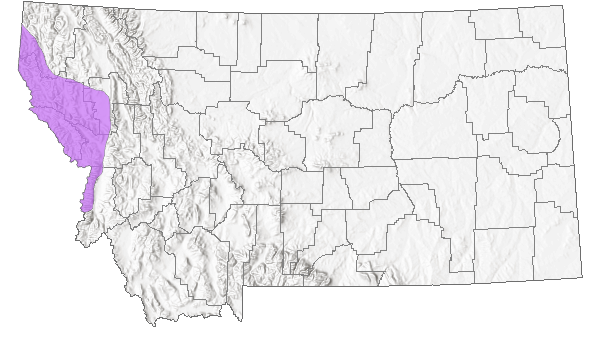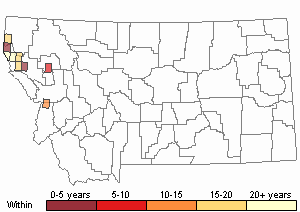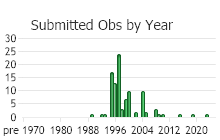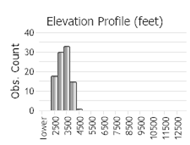View in other NatureServe Network Field Guides
NatureServe
Montana
Utah
Wyoming
Idaho
Wisconsin
British Columbia
South Carolina
Yukon
California
New York
Diamond Clarkia - Clarkia rhomboidea
State Rank Reason (see State Rank above)
Rare in Montana, where it is known from only a small portion of the northwest corner of the state, primarily along the lower Clark Fork River drainage. Some detrimental impacts from invasive weeds and subsequent herbicide treatments are possible as are loss of habitat due to fire suppression.
- Details on Status Ranking and Review
Population Size
Score1 - Moderate: Generally 10,000-100,000 individuals.
Range Extent
Score2 - Regional or State Endemic or Small Montana Range: Generally restricted to an area <100,000 sq. miles (equivalent to 2/3 the size of Montana or less) or Montana contributes 50% or more of the species’ range or populations OR limited to 2-3 Sub-basins in Montana.
Area of Occupancy
Score1 - Moderate: Generally occurring in 11-25 Subwatersheds (6th Code HUC’s).
Environmental Specificity
Score1 - Moderate: Species is restricted to a specific habitat that is more widely distributed or to several restricted habitats and is typically dependent upon relatively unaltered, good-quality habitat (C Values of 5-7).
Trends
ScoreNA - Rank factor not assessed.
CommentTrends unknown, though some habitat degradation has occurred.
Threats
Score2 - High: 31-70% of the populations are being negatively impacted or are likely to be impacted by one or more activities or agents, which are expected to result in decreased populations and/or habitat quality and/or quantity.
CommentInvasive weeds are common at some sites and have the potential to invade other locations. The severity of impacts is uncertain.
Intrinsic Vulnerability
Score1-2 - Moderate to High Vulnerability.
Raw Conservation Status Score
Score
8 to 9 total points scored out of a possible 16 (Rarity factors and threats only).
General Description
Common Clarkia is an annual with mostly unbranched stems that are 15-50 cm tall. The few leaves are opposite and have 1-3 cm long petioles and lance-shaped to elliptic, entire-margined, 2-7 cm long blades. The herbage is sparsely covered with short hairs. The few flowers are borne in a loose, narrow, nodding inflorescence which terminates the stem; the 4 separate petals are spoon-shaped, 5-10 mm long, and rose-purple, often with purple dots. The ovary is club-shaped and below the point of attachment of the petals. The fruits are capsules which are 1.5-3 cm long; each has a short beak at its tip.
Phenology
Flowering in late May-June.
Diagnostic Characteristics
The species is most easily confused with Epilobium, but can be distinguished by having seeds without a tuft of hairs at the tip.
Species Range
Montana Range
Range Descriptions

 Native
Native
Range Comments
Collected in Lake, Lincoln, Ravalli, and Sanders counties in Montana. It occurs from WA to MT south to CA, AZ and UT (Lesica et al. 2012. Manual of Montana Vascular Plants. BRIT Press. Fort Worth, TX).
Observations in Montana Natural Heritage Program Database
Number of Observations: 103
(Click on the following maps and charts to see full sized version)
Map Help and Descriptions
Relative Density

Recency



 (Observations spanning multiple months or years are excluded from time charts)
(Observations spanning multiple months or years are excluded from time charts)
Habitat
Dry, open forest slopes with gravelly soils in the montane zone.
National Vegetation Classification System Groups Associated with this Species
Forest and Woodland
Low Elevation - Xeric Forest and Woodland
Montane - Subalpine Forest and Woodland
Shrubland
Foothills - Montane Shrubland
Stewardship Responsibility
Threats or Limiting Factors
STATE THREAT SCORE REASON
Reported threats to Montana's populations of Diamond Clarkia refer to noxious and other non-native plant populations and subsequent impacts from chemical herbicide used to control invasions (MTNHP Threat Assessment 2021). Dalmatian Toadflax (Linaria dalmatica), Spotted Knapweed (Centaurea stoebe) and Cheatgrass (Bromus tectorum) are found with many populations, and several of these reports describe heavy infestations.
References
- Literature Cited AboveLegend:
 View Online Publication
View Online Publication Lesica, P., M.T. Lavin, and P.F. Stickney. 2012. Manual of Montana Vascular Plants. Fort Worth, TX: BRIT Press. viii + 771 p.
Lesica, P., M.T. Lavin, and P.F. Stickney. 2012. Manual of Montana Vascular Plants. Fort Worth, TX: BRIT Press. viii + 771 p. MTNHP Threat Assessment. 2021. State Threat Score Assignment and Assessment of Reported Threats from 2006 to 2021 for State-listed Vascular Plants. Botany Program, Montana Natural Heritage Program, Helena, Montana.
MTNHP Threat Assessment. 2021. State Threat Score Assignment and Assessment of Reported Threats from 2006 to 2021 for State-listed Vascular Plants. Botany Program, Montana Natural Heritage Program, Helena, Montana.
- Additional ReferencesLegend:
 View Online Publication
View Online Publication
Do you know of a citation we're missing? Lesica, P., M.T. Lavin, and P.F. Stickney. 2022. Manual of Montana Vascular Plants, Second Edition. Fort Worth, TX: BRIT Press. viii + 779 p.
Lesica, P., M.T. Lavin, and P.F. Stickney. 2022. Manual of Montana Vascular Plants, Second Edition. Fort Worth, TX: BRIT Press. viii + 779 p. Smith-Huerta, N.L. 1984. Seed germination in related diploid and allotetraploid Clarkia species. Botanical Gazette 145(2):246-252.
Smith-Huerta, N.L. 1984. Seed germination in related diploid and allotetraploid Clarkia species. Botanical Gazette 145(2):246-252. Vanderhorst, J.P. 1997. Status review of Clarkia rhomboidea in Montana. Unpublished report to the Kootenai National Forest. Montana Natural Heritage Program, Helena, MT 19 pp. plus appendices.
Vanderhorst, J.P. 1997. Status review of Clarkia rhomboidea in Montana. Unpublished report to the Kootenai National Forest. Montana Natural Heritage Program, Helena, MT 19 pp. plus appendices.
- Web Search Engines for Articles on "Diamond Clarkia"





